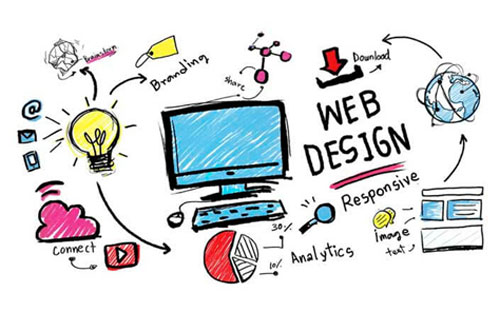For designers wishing to work in this booming business, web design has fast become an essential talent. Web design might be complicated and intimidating, but with the advancement of the Internet and technology, it is now easier than ever before. There are numerous tools available on the Internet, and anyone can learn to create a fantastic website on their own. If you’re interested in learning more about this creative field, read on because I’ll show you how even amateurs may get started with web design by following this easy guide.
What is Web Designing?
The process of organizing and presenting content on a website so that it may be shared and accessed by people all over the world is known as web design. Web design is composed of aesthetic and functional aspects that influence the look of a website, including colors, fonts, and graphics, as well as the layout and user-friendliness.
Web design is frequently a collaborative process that brings together knowledge and tools from various industries, ranging from web design statistics to SEO optimization and user experience design. Professionals from various fields are frequently brought together by web designers to maximize performance and focus on the bigger process and outcome.

Steps and skills to get your web design project off to a good start
We’ve broken down the most significant parts and steps of modern website design that you can use to increase your site’s performance to help you define your focus and find the ideal abilities for your site.
Understand Layout Design
Layout design is the process of arranging visual components on a page, such as text, photos, and shapes. Layout design is crucial for website design since it determines the overall appearance and relationship between graphic components on the page, allowing for a seamless message flow and maximum performance.
Get to know the principles of visual design.
Simply said, visual design is the act of using visual components and effects to improve the UI and UX of a website or app, such as colors, graphics, imagery, typography, layouts, white spaces, and so on. It focuses more significantly on the visual effects of web/app design and tries to engage consumers, as opposed to UI design. If you’re a newbie looking to create a fantastic visual design, keep in mind the basic principles of scale, visual hierarchy, balance, contrast, and overall aesthetics, which can help you boost usability and generate engagement.
Learn the fundamentals of coding (HTML, CSS)
Web design is not the same as software programming, and you do not need to learn front-end development. However, as a designer, having a basic understanding of coding allows you to interact more effectively with developers. These days, there are numerous great and free online websites for rookies to learn coding. You can even enroll in short online courses to gain a more comprehensive understanding of coding.
Mastering the concepts of interaction design
The goal of interaction design is to create engaging interfaces with well-considered responses. Basic knowledge of interaction design, such as defining design strategies, identifying essential wireframe interactions, and prototyping interactions, is required for web designers in order to provide a user-friendly experience for their users.
Know your company’s product as well as the target audience
Whether you’re a beginner or a seasoned designer, the goal of your work is to communicate the value of your product or service to your target audience. So, before getting into the technical aspects of web design, the most crucial skill for a designer is to have a clear identity of the business and create a design that fulfills your consumers’ needs, so that you have a mindset about what kind of website you want.
The essential components of web design
It’s time to start the actual web design while focusing on these basic web design components given below after you’ve mastered all of the skills above and have a clear notion in your mind about how you want your website to connect with your clients.

Overall design
The general appearance of your website is an important aspect of web design. Studies show that users generate opinions about your website or business in just 50 milliseconds, and that opinion will influence whether they remain or leave. As a result, make your design basic, clear, and accessible while also using grid-based designs to keep design things structured and tidy, resulting in a fantastic overall layout.
Color palette
The color combination and fonts on your site will have a direct impact on the perceptions of your visitors, and this is where most new designers begin. Are you confused about your color scheme? Simply consulting your brand or industry viewpoints, as well as your target market demographics, will help you save time and make this a relatively simple process.
Optimization of Performance
To shorten the time between click and content, you must optimize all parameters to improve parts of your site for performance. In practice, this involves balancing image resolution and file size across all photographs. PNG images, for example, have superior quality and transparency but are significantly larger than JPEG images; whereas, JPEGs provide the optimum mix of speed and quality. Any files hosted on your site should also be compressed. Furthermore, site owners should think about their hosting environment: Exclusive or VPS hosting, for example, will often provide better site loading times than shared hosting.
Typography
Your choice of font while building your company’s website can give away subtle clues about what you stand for. Is your company lighthearted or serious? Is it more functional or informative? Whatever font you choose, make sure your designer considers its compatibility with different browsers and machines. If you use a typeface that isn’t supported by most browsers and PCs, your website may end up looking strange on different devices.
Navigation
The menu elements must be easily accessible from any page, and the web design should be simple to navigate. The user should always identify where they are on the website and have quick access to the areas they want to see. A site map is a terrific concept, and if one is provided, it would be used. This may seem obvious, yet most websites may need some work in this area. Remember that there’s a thin line between an interactive menu and one that’s unpleasant, so focus on functionality.
Content
This is the foundation of your site. Your content not only affects your search engine rating, but it’s also why most people visit your site in the first place. The content on your website should be useful, simple to read, and brief. More than anything else, well-written web content and text will make your website design entertaining, effective, and popular. Unnecessary words can get in the way and dull your brand’s main selling qualities, therefore efficiency is vital. So, to keep your material organized and relevant, think short and sweet.
Conclusion
Modern web design necessitates constant assessment to ensure that your site provides captivating graphics, engaging content, and a cohesive user experience across all devices. Remember that learning is the only way to attain your goal, whether you are a beginner or a skilled designer. You can use the above guide in addition to taking online web design classes, subscribing to educational blogs, reading best design books, and learning from professionals, or watching free YouTube tutorials. The principles outlined above provide a solid foundation for creating attractive, clean, and fast websites that pique user interest and encourage conversions.
Also Read:
~ News4masses is now also on Google news
~ If you want to contribute an article / story, please get in touch at: news4masses[at]gmail[dot]com




















[…] ~ News4masses is now also on Google news ~ If you want to contribute and have specific expertise, please get in touch at: [email protected] […]
[…] ~ News4masses is now also on Google news ~ If you want to contribute and have specific expertise, please get in touch at: contact@news4masses.com […]